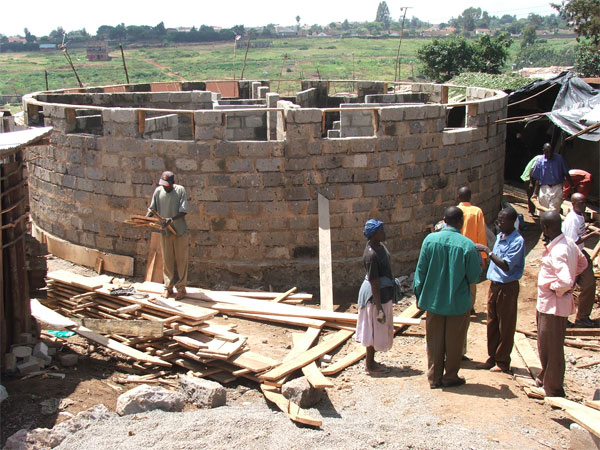Afrigadget has some excellent photos of a novel design for a latrine in the Nairobi Kibera neighborhood. Kibera is a huge neighborhood, home to approximately 500,000 residents, very few of whom have access to running water or sanitary facilities in their homes. Some Kibera residents live close enough to pit latrines to use these facilities – others are forced to rely on the less sanguine system of “flying toilets” (i.e., putting human waste into a plastic bag and throwing it as far from your house as you can) because of the cost of latrines or the danger of walking the neighborhood at night.

Photo from Afrigadget.com
The biolatrine probably won’t help with the safety issue, but may well help with the issue of cost. According to an article on IslamOnline.net by Wanzala Bahati Justus, the latrine uses a biogas system used widely in Southeast Asia to convert animal waste into methane and adapts it for human waste. The latrine looks much like a standard pit latrine, but waste goes into a huge “bio-digester”, a large underground dome, which stores sludge for 120 days, releasing methane.
The methane is being used to light and cook meals at a nearby school. The volume of methane produced is large enough that the latrine may be able to sell some of the gas and use the profits to subsidize the costs of operating the latrine. There’s a second environmental benefit from the use of methane as cooking gas – the more common alternative of charcoal has major negative implications for Kenya’s forests, especially those near urban areas. If the latrine operators are able to find a market for the fertilizer (the solid remains of the sludge after it’s processed for 120 days), the chances for fiscal sustainability increase.
One of the major challenges with launching projects like these in informal settlements is questions about ownership of the land, as Robert Neuwirth outlines in book “Squatter Cities” – it’s hard to invest in building structures like this one if there’s uncertainty about whether the “legitimate” property owner will order the structure bulldozed. Here’s hoping this experiment with biogas latrines will survive and inspire more of the same in the Kibera area.
My friend Cyrus Farivar points out that there have been other experiments with human waste to methane, including an award-winning project at a prison in Rwanda – Cyrus wrote an excellent story for Wired News on the topic.
surely its a nice idea please sent me an idea to make a bio gas plant (small )at my home
Comments are closed.